Too Big to Fail
Hartford (Google Maps location)
October 2009
Connecticut Museum Visit #142.
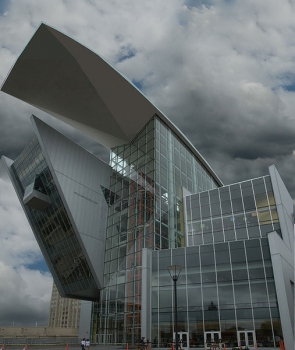 Hm. Um. Uh-huh. Here in Connecticut there are only a few gigantor museums, so my experience thus far in blogging about them is scant. And I’m scared. Scared for a couple reasons, really… One, the sheer size and variety within the new Connecticut Science Center is just plain daunting. And two, despite the fact that I’m a science nerd who loves museums, despite the fact that the folks at the CSC were more than kind to me on a couple occasions, despite the fact that no one wants a world-class museum in Hartford more than I do, and despite the fact that I became sort of friendly with the media liaison there… I was not, how should I say, overly impressed with the multi-million dollar joint.
Hm. Um. Uh-huh. Here in Connecticut there are only a few gigantor museums, so my experience thus far in blogging about them is scant. And I’m scared. Scared for a couple reasons, really… One, the sheer size and variety within the new Connecticut Science Center is just plain daunting. And two, despite the fact that I’m a science nerd who loves museums, despite the fact that the folks at the CSC were more than kind to me on a couple occasions, despite the fact that no one wants a world-class museum in Hartford more than I do, and despite the fact that I became sort of friendly with the media liaison there… I was not, how should I say, overly impressed with the multi-million dollar joint.
(The picture, at left, is from WikiCommons because I can’t find my own right now.)
But know this: You should all visit at least once or twice and if you have kids, you should go multiple times. It’s totally worth it and your kids will have fun. Heck, you will too. Trust me. On top of that, the museum’s mission is excellent – they  engage the visitor (no matter the age), rather than just talk at them. This may sound pithy reading it here, but it’s true. And they do a great job of that.
engage the visitor (no matter the age), rather than just talk at them. This may sound pithy reading it here, but it’s true. And they do a great job of that.
But for this jaded museumophile, something was missing. You’ll see what I mean if you read the words among all the pictures.
Now, you could just stop reading here and instead click here and read all the glowing press clippings about the CSC. Or, if you’re a little more curious, you could read the following cut-and-paste from their About page:
With 150 hands-on exhibits, a state-of-the-art 3D digital theater, four educational labs, plus daily programs and events, the Connecticut Science Center offers endless exploration for children, teens and adults. Every part of science will be at a visitor’s fingertips, from Physics to Forensics, Geology to Astronomy.
The Connecticut Science Center has changed much more than a skyline. Our unique features will captivate millions of visitors over the years. The constant stream of visitors will mean business for Connecticut hotels, restaurants and retailers year round.
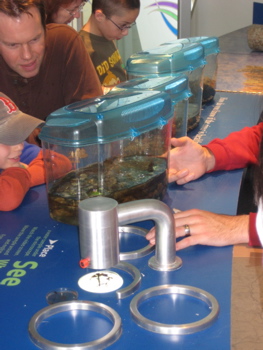 The implications for Connecticut’s science education are just as promising as the economic benefits. The Science Center offers exciting tools to help educators and parents bring textbooks alive. Creating unforgettable experiences with science motivates students and visitors of all ages to enthusiastically embrace science at school, at home, and in their communities.
The implications for Connecticut’s science education are just as promising as the economic benefits. The Science Center offers exciting tools to help educators and parents bring textbooks alive. Creating unforgettable experiences with science motivates students and visitors of all ages to enthusiastically embrace science at school, at home, and in their communities.
With an attraction of this magnitude, exhibits rivaling the most unique in the worlds, programs with the potential to become national models, partnerships with a range of educational organizations, and involvement from global business leaders and benefactors, the prospects are here for Connecticut to position itself for the future as “The Science State”.
Okay, now maybe their sic of “worlds” was actually a cheeky joke; implying that our blue planet is not the only life sustaining planet in the universe. And I applaud their gumption in declaring their wish to have our little state become “The Science State.” As one with a science degree from the state university, that would make me proud.
But let’s back up a minute.
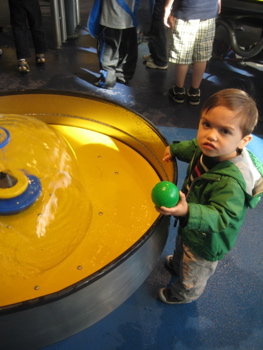 The Center’s mere existence is a bit controversial. First, it’s in Hartford. You see, many suburbanites harbor a paralyzing fear of the capital city. They will look you in the eye and tell you they think they will be murdered if they step foot on a Hartford sidewalk. They make no distinction between Front Street and Adriaen’s Landing where the Center is and the North End. They are stupid, ignorant and myopic.
The Center’s mere existence is a bit controversial. First, it’s in Hartford. You see, many suburbanites harbor a paralyzing fear of the capital city. They will look you in the eye and tell you they think they will be murdered if they step foot on a Hartford sidewalk. They make no distinction between Front Street and Adriaen’s Landing where the Center is and the North End. They are stupid, ignorant and myopic.
These people will call you a liar when you tell them that New Haven had 24 murders in 2010 and Hartford had 25. Of those 25, almost every single one happened in the DMZ of the north end among rival drug dealers and their clientele. None have happened “downtown” near the river. Zero. (I just looked it up.) But this is a major hurdle to overcome for the science center. Here’s a sample of comments (which will disappear soon) on a Courant article about the Center’s first year performance:
“I’d say that just the fact that nobody has been killed in the parking lot yet makes it a success!”
Note to this genius: The Center, which is right off the highway, has its own parking lot underneath the building which is very well protected and is at least a mile away from any residential areas. You are safe there.
” I’m figuring this will be just like every other project Hartford has come up with in the past two decades…a mismanaged, dismal failure that will sit decaying within 10 years.”
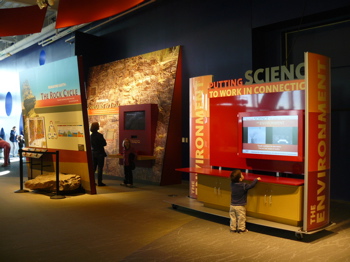 ” The problem lies in locating this ill-conceived and hasty replacement to an NFL stadium in an area completely lacking in values (or interest in science, for that matter). NOBODY- and I don’t care how you want to polish this turd- wants to come in from the suburbs and have to endure the dregs of society that run roughshod through the place.”
” The problem lies in locating this ill-conceived and hasty replacement to an NFL stadium in an area completely lacking in values (or interest in science, for that matter). NOBODY- and I don’t care how you want to polish this turd- wants to come in from the suburbs and have to endure the dregs of society that run roughshod through the place.”
The dregs are selling crack here? In the Space exhibit or the Body one? 365,000 visitors passed through the Center’s doors in its inaugural year. At least 3 were from the suburbs.
And finally, the best one is this: “ If the kids want to learn about science and see real science and biology and physics, bring them up to the North End of Hartford, they can learn about gun ballistics, how fast a bullet travels, the projectile and velocity of a bullet, the chemical composition of a bullet, and then look at the body with the bullet hole in it and can learn stuff about human biology, where the main veins are, how the body requires oxygen, teach them about the Doppler effect when the ambulance siren approaches…. the real science and teachable moments are right up there on Albany Avenue, not down by Adrian’s Landing…”
Points for creativity. But minus one for misspelling Adriaen. So you see, anything that Hartford does is doomed from the start. I’m not here to pretend Hartford is a perfect city – it’s not. But it’s hardly the apocalyptic hellscape these Courant commenters seem to think it is. I worked in Hartford for years. I have plenty of friends who live there and I go into the city quite frequently – at night! And I’m still alive and my car even has all its hubcaps.
So once you get past the idea of being murdered, there’s the boondoggle aspect of the place. It cost $162 million bucks or so. The state bestowed a healthy 15% subsidy to help with the annual 8.5 million dollar operating budget (since reduced by half due to the recession, but probably will be upped again soon.) And a story that got very little play in the media was that the beautiful Cesar Pelli designed building was structurally unsound. It leaked and was in danger of falling onto I-91 below. (I assume they fixed those shortcomings… at a cost.)
The Center is to be THE showcase of the downtown redevelopment known as Front Street/Adriaen’s Landing/Riverfront Recapture. Of course we’ll have to recheck back with how everything’s doing in five or ten years, but it does seem to be a success as we approach its two-year birthday… And no one’s been killed there yet either. In fact, as I scour the Intertubes, almost every blog post and news item and opinion piece about the Science Center is overwhelmingly positive.
 There are grumbles and gripes about the cost, which I think IS rather high, but beyond that the visitors enjoy the CSC. So what’s wrong with me? Nothing – I DID enjoy the place, but had some issues. Here are my gripes:
There are grumbles and gripes about the cost, which I think IS rather high, but beyond that the visitors enjoy the CSC. So what’s wrong with me? Nothing – I DID enjoy the place, but had some issues. Here are my gripes:
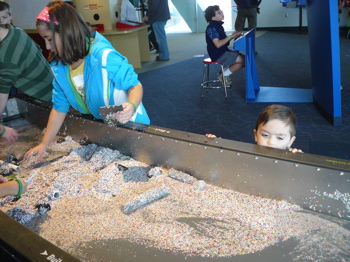 heartbreaking to see a 9-year-old fatso push my 4-year-old non verbal special needs kid aside to get at some buttons to push. It’s not necessarily the staff’s job to monitor that behavior, but is it too much to ask someone to be present to watch over the more popular gizmos?
heartbreaking to see a 9-year-old fatso push my 4-year-old non verbal special needs kid aside to get at some buttons to push. It’s not necessarily the staff’s job to monitor that behavior, but is it too much to ask someone to be present to watch over the more popular gizmos? 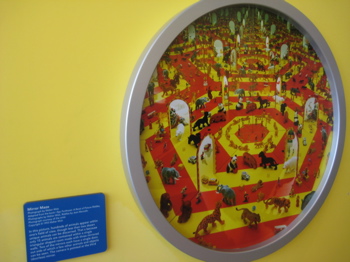 matter how superfluous that “interaction” may be. In this day and age kids demand interactive media and they have it at their fingertips 24-7. So they’re not going to be impressed by flawed design and really, maybe we should be teaching these same kids to stop, read, and think once in a while.
matter how superfluous that “interaction” may be. In this day and age kids demand interactive media and they have it at their fingertips 24-7. So they’re not going to be impressed by flawed design and really, maybe we should be teaching these same kids to stop, read, and think once in a while.That reminds me – I wrote an article for AAM’s Museum magazine about one exhibit at the museum. This ONE exhibit did highlight Connecticut inventors, but still missed the boat on what I thought could have been a really cool story which writes itself by merely looking out the giant windows to the east. I sort of touched on that idea in an article I wrote, which I will reprint here. Museum won’t mind. I hope:
Inviting Inventions
When out-of-staters are asked what springs to mind when Connecticut is mentioned, the answers usually involve Mystic, money or ESPN. The towering new César Pelli-designed Connecticut Science Center in Hartford is positioned to update those perceptions.
Standing in the sixth-story viewing area overlooking the Connecticut River and hills beyond, one can gain a very real sense of the past, present and future. Looking south, less than a mile down the river stands the iconic Colt’s Manufacturing Co., whose famous founder invented and began manufacturing revolvers in the mid-1800s. And just across the river from the science center is the headquarters of Pratt & Whitney, the company that invented and then continued to perfect jet-engine technology through the 20th century.
These companies exemplify the spirit of invention in Connecticut. Invention often requires thinking about an existing form in a new way. This construct is interpreted, explored and encouraged at the science center’s permanent one-room exhibition titled “Invention Dimension.” The exhibit successfully blends the history of invention in Connecticut with hands-on activities that dare participants to think in new and creative ways.
Most of the historical displays that line the walls are presented using the latest in touch-screen technology—right alongside some good old-fashioned inventions. Some of these include an entire Pratt & Whitney RL10 rocket engine, a Wiffle ball, an Ovation guitar and a Colt revolver. “The exhibit started off rather static,” says Richard Thomas, the center’s director of exhibits. “Creating displays that explore the act of invention was the challenge.”
One way the center bridges the gap between learning and doing is through interpretive stations explaining several local inventions. The room is arranged so visitors can choose their own paths—skipping around as they wish, creating their own experiences.
One learns, for instance, that Samuel Colt spent some time on a sailing ship to India as a young man. As he whiled away the hours, he began thinking about the spokes of the ship’s huge steering wheel and realized that, according to the narrative text at the museum, “regardless of which way the wheel was spun, each spoke always came in direct line with a clutch that could be set to hold it. . . . And the revolver was conceived!” Colt then carved a prototype of his revolutionary idea from a piece of wood, and that ultimately served as a model for the gun that modernized firearm technology.
This sort of creative thinking is what “Invention Dimension” celebrates and encourages. Says Thomas, “We thought long and hard about how we could engage the visitor with the act of inventing something.” Upon entering the exhibit, for instance, visitors are greeted by an animatronic palm tree. A closer look reveals that the tree and its fronds are artfully constructed from household items such as plastic cups and combs. The installation by Steve Gerberich, cleverly titled Kineticutt, is the first introduction to the concept of invention.
“Practice looking at things differently,” the exhibit suggests, just like Colt and the other featured Connecticut inventors. Visitors are immediately thrust into doing just that—thinking about problems and ordinary objects in different ways. The hands-on “Imagination Zone” allows for young and old visitors to attempt various mind-bending geometric challenges. Like all the exhibits here, “Imagination Zone” has limited text panels telling visitors what to do, which is an intentional design concept to invite active participation with principles and learning through experimentation.
For those who get stuck or have questions, the center employs “gallery scientists” to engage visitors. They are thankfully approachable, possessing a great combination of personality, passion for science and the ability to ably speak with 5-year-olds and retired Ph.D. holders alike.
One activity led by the gallery scientists encourages visitors to design a bridge from uncooked spaghetti. This is further inspired by the clear view through the huge wall of windows of two bridges spanning the Connecticut River just below. The spaghetti bridges are tested for strength and, as is the goal of the activity, “the kids are learning without realizing,” says Thomas. A running tally of the highest tensile strengths is posted on the wall, giving everyone a tangible goal to reach.
“We focused heavily on balancing amusement versus content,” Thomas says. “The three Rube Goldberg-type contraptions around the space encourage the visitors to utilize a different thinking process—to think like inventors think.” These large, labyrinthine structures require visitors to place several golf balls strategically along a course, setting off a series of triggers to achieve success.
Further encouraging this “different thinking process” is a station called the “Idea Generator,” where photos of unusual vehicles and historic manned-flight inventions help inspire creativity. The idea behind the accompanying displays is the same: How can we train our brains to begin thinking about common, everyday objects in very different yet practical ways?
Not every station hits the mark. One is a tower of so-called “hack toys” —basically a collection of used, sound-producing children’s toys re-imagined as a somewhat cacophonous Tower of Babel. The display maintains the spirit of the room, but the execution is a bit lacking.
While “Invention Dimension” did not set out to do so, it symbolizes what the Connecticut Science Center is aiming to achieve in a much broader sense. Hartford, like many mid-size American cities these days, is facing financial difficulties and is struggling to attract investment and retail dollars. Through its soaring and stunning architecture, which can be seen for miles on the interstates that bisect the capital city, the center is succeeding in making people think about Hartford and the region in a new way.
With an attraction of this magnitude and programs with the potential to become national models, Connecticut is primed to position itself as not only the Mystic, money and ESPN state, but also the “Science and Invention State.”
Eh. Not my best work, but it paid a few bills. So now you know far too much about what’s wrong with the place, why some people say it will fail miserably and about one particular exhibit.
I see no real need to walk you through floor by floor, exhibit by exhibit. And let’s be honest, no way would you read that 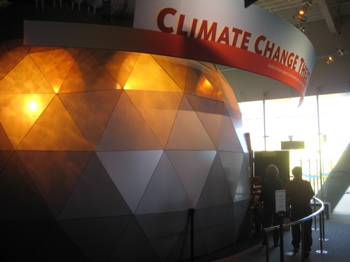 anyway. And so, having written more than enough already, I’m just going to sort of give you the highlights and a bunch of pictures that go along with them.
anyway. And so, having written more than enough already, I’m just going to sort of give you the highlights and a bunch of pictures that go along with them.
I should note that there is a huge kinetic mobile hanging in the lobby. I had the good fortune of seeing some other work by Tim Prentice at the Mattatuck Museum in Waterbury a couple months prior. (CTMQ Visit here.)
Once paid and through, the “intro” area is a great little introduction to the whole hands-on concept of the museum. It’s just for little kids (and their parents), and it has the potential of being a mess; but a fun mess indeed.
There are some cool Walter Wick items on the wall here as well. Wick is a Connecticut resident and you all know at least some of his incredible and unique work – the “I Spy” books. I reached out to his studio once in an effort to get a tour, but was rebuked. His lackeys apparently don’t know who I am!
After your kid is sufficiently doused from all the vortexes and dams and whatnot, you must ride the elevator up to the sixth, fifth, or fourth floor. (The 2nd and 3rd floors are taken up by offices and I think the theater.) We started at the top on the 6th floor.
There are a few exhibits up here, but for me the highlight is the massive glass window area overlooking the Connecticut River and beyond. The museum focuses on the biology of the river below and the hills all around, but sometimes it’s nice to see the city in a positive light from up on high.
The exhibits up here focusing on the River way down there are The River of Life and one of the coolest: River’s Journey. Here, you 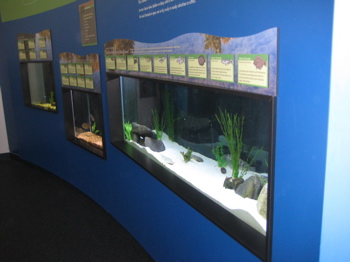 can virtually fly a helicopter from the Connecticut’s source up near Canada down to the Long Island Sound, pausing here and there to learn about the various landmarks along the way. I had a little too much fun with this one, while Damian and Hoang were over checking out the live aquarium animals.
can virtually fly a helicopter from the Connecticut’s source up near Canada down to the Long Island Sound, pausing here and there to learn about the various landmarks along the way. I had a little too much fun with this one, while Damian and Hoang were over checking out the live aquarium animals.
There’s a wet lab up here too, where a Gallery Scientist or two is present to help the kids learn and experiment. The gallery scientist program is really just plain great, and it’s a shame I can’t find that much on the CSC website about it. As a sidebar to the article I wrote, I did interview one of the scientists who clearly loved his job and explained why very well.
Basically, these scientists are actually real scientists who man various experimental exhibits engaging the visitors. And that’s the key; not just showing the principles, but challenging those interested and encouraging them to apply hard science themselves – often without even realizing it. And to me, that’s really the star of the show at the entire museum.
Moving on, the next area is titled “Planet Earth” and it delves into geology and meteorology and other environmental issues. Like many children’s museums, there is a green screen and video camera set up for visitors to give a weather report. I think this is the fourth museum Damian has had the opportunity to drop some on screen knowledge (Children’s Museum in West Hartford, Children’s Museum of Southeast Connecticut in Niantic, Stepping Stones Children’s Museum in Norwalk are the others).
The last major area up on the 6th floor is a whole environmental “green” area. Lots of stuff about solar energy and renewable resources and a “global warming” exhibit. I really wish they’d make the effort to call it “global climate change,” but that’s not my main beef with the display.
Here’s their description of the display: “It’s not often you get schooled about the effects of global warming by a sheep. But who better to give us a perspective on what’s happening with the earth’s environment than an animal? Our 30-seat, 4D object theater 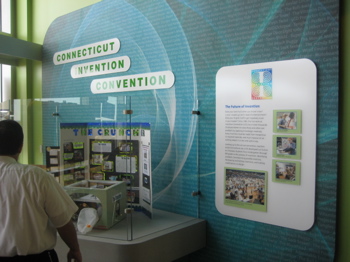 provides a sensory extravaganza, complete with booming thunderstorm and actual rainy mist (that’s the fourth dimension), as our farmyard narrator dishes out a 20-minute presentation that’s anything but woolly.”
provides a sensory extravaganza, complete with booming thunderstorm and actual rainy mist (that’s the fourth dimension), as our farmyard narrator dishes out a 20-minute presentation that’s anything but woolly.”
Okay. So you use a sheep?!! I just envision every climate change denying wingnut guffawing about the irony of the center using a sheep. (Now, I didn’t see this movie, so maybe they play up that irony and I’m the fool here… but that would surprise me to say the least.)
The entire “Energy City” area held no interest for Damian. I found it a bit too wordy for most kids, but then again, it’s cool to have stuff for pre-teens in museums once in a while. And quite frankly, the CSC excels for that demographic.
Before going down to the 5th floor, we ventured out onto the roof terrace. The garden wasn’t much more than weeds during our visit (I’m sure that’s been upgraded), but the outdoor area was still pretty cool. We were fortunate to visit while a part of the awful Constitution Plaza was being dismantled – including the WFSB building after their move to Rocky Hill. Damian and I enjoyed watching the activity for as long as anything inside the museum.
On the 5th floor, we first checked out the Sports Lab exhibit. This mostly dealt with the physics of sports, which is obviously a good way to engage the kids. I liked the bicycle helmet test area; scaring children to protect their noggins is always good. I just clicked on the “learn more” section of the CSC website for this area and read:
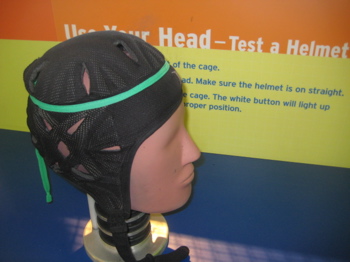 “When hockey pucks were first introduced around 1860 they were made of mostly rubber-like material. While today’s pucks aren’t entirely rubber, they are synthesized with materials that give them elasticity. Because of this, pucks must be kept in a freezer, even between periods, because any heat added also adds energy to the puck, making it bounce higher and harder to stick-handle.”
“When hockey pucks were first introduced around 1860 they were made of mostly rubber-like material. While today’s pucks aren’t entirely rubber, they are synthesized with materials that give them elasticity. Because of this, pucks must be kept in a freezer, even between periods, because any heat added also adds energy to the puck, making it bounce higher and harder to stick-handle.”
Hey man, any museum that talks about hockey is alright in my book. There are a bunch of displays about how sports equipment is made and how it helps the athletes. There is even an interactive computer that tells you what sport you’d most enjoy/excel at. I think it told me I’d like long-distance running… which is absurd. While I WAS good at it back when I was in shape, it bores the pants off of me.
The other half of the room is occupied by the Picture of Health exhibit. Here, you can learn an impressive array of things about 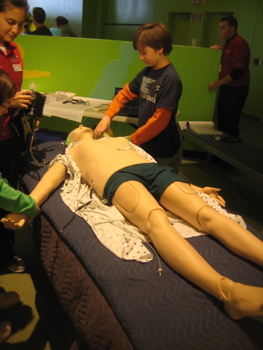 your body. We spent a good amount of time here, as the interactivity seemed to be at a higher level than at some other places. Plus, Damian really enjoyed feeding the virtual lady massive amounts of food to watch her diabetes skyrocket. There were lifespan predictors and all sorts of ways to determine how healthy – or unhealthy you are.
your body. We spent a good amount of time here, as the interactivity seemed to be at a higher level than at some other places. Plus, Damian really enjoyed feeding the virtual lady massive amounts of food to watch her diabetes skyrocket. There were lifespan predictors and all sorts of ways to determine how healthy – or unhealthy you are.
There’s also a genetics station, which did explore a little bit more about genetics than you may expect. We tried to explain to Damian that his particular chromosomal deletion (Damian has Smith-Magenis Syndrome, which you can read more about here) but he just went back to feeding the computerized lady more cheese. (Come to remember it, this was the thing that Damian got bullied off of a couple times, resulting in tears.)
Across the concourse is the Invention Dimension area I discussed in that article I posted earlier. I didn’t really get into some of the faults of the area though. This is where so many things look really cool and interesting and challenging and then just sort of fall flat. But they do get bonus points for having a whole wall of CT Inventions. I knew most of them before visiting, but not all. The CSC website lists a bunch – I could show how half of them are celebrated in museums from Naugatuck/Waterbury (Naugahyde) to the cotton gin (Hamden) to the submarine (Essex) to the cylindrical lock (Terryville), but I won’t.
The last portion of the 5th floor is arguably the coolest area in the museum: Exploring Space.
I think (aside from the initial water area) this was Damian’s favorite area at least. There are a bunch of cool pods to sit in and “fly” through space as well as computerized tables where you can “land on the moon” and stuff like that. I’m totally glossing over a bunch of stuff in this room, but again – you’ll most likely check it out yourself someday so you’ll form your own opinions.
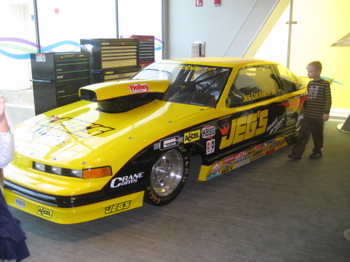 Time to head on down to the 4th floor.
Time to head on down to the 4th floor.
Half of this floor is taken up by the Traveling exhibit area. The space is HUGE and therefore will undoubtedly host a whole bunch of really cool stuff over the years. During our visit, there was a whole thing about speed. There was an entire funny car there (!) with all sorts of speed tests and crash test dummies and race tracks and things of that nature. It was more impressive in its size than its execution.
Across the hall were the exhibits I think I most wanted to immerse myself in. The first one was Sight and Sound and to let the museum explain it, “Check out this edgy mashup of art and music and science. We’ve got exhibits where you can actually feel sound. We’ve got others where you can hear light. You’ll use lasers, sophisticated software and the movements of your own body to create perfect harmonies in all kinds of musical stylings, plus multisensory performance art experiences. By comparison, those rock and roll video games are just posing. “
Awesome, right? Unfortunately, this is where most of the broken stuff was. Again, I realize that much of this is very technical and probably too fragile to have at a kid-friendly science center. But man, I so wanted to be on the radio with Courney from 95.7 and I had high hopes of putting together a dope drum and bass beat at the deejay station.
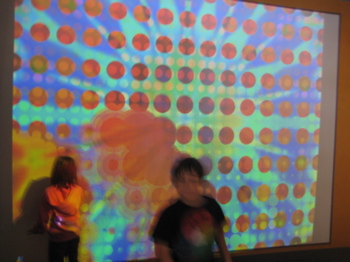 Regardless, the mixture of art and music was still pretty cool and I had a lot of fun. We all also had fun next door in the “Forces in Motion” area. Here, magnets and flight are explored and explained. Now, I was going to post some stuff about a current Internet meme about “[Bleepin] Magnets, how do they work?” which came about via some moronic terrible rappers who wear clown makeup and how they claim magnetism is a “miracle” because they don’t understand it.
Regardless, the mixture of art and music was still pretty cool and I had a lot of fun. We all also had fun next door in the “Forces in Motion” area. Here, magnets and flight are explored and explained. Now, I was going to post some stuff about a current Internet meme about “[Bleepin] Magnets, how do they work?” which came about via some moronic terrible rappers who wear clown makeup and how they claim magnetism is a “miracle” because they don’t understand it.
But I won’t. I mean, heck, all one needs to do is visit the Connecticut Science Center to learn how magnets work. And no need to be any older than seven. There’s even a working maglev train set up here that is beyond cool. Also, some of the physics of flight 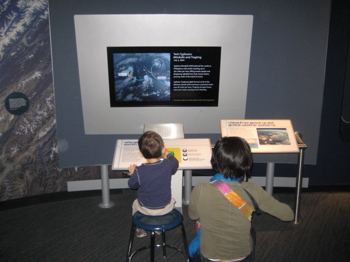 exercises are super fun. Even Damian made a flying helicopter that was shot out of a tube high in the air.
exercises are super fun. Even Damian made a flying helicopter that was shot out of a tube high in the air.
A family can expect a visit to the science center to last at least two hours, perhaps more with lunch and a movie. It is an ambitious investment for the state and like I said, it appears to be a success so far. My earlier complaints must be weighed against the fact that my visits were all in October of 2009, mere months after opening.
I very much hope the center remains open and thriving for the rest of our lives. They are highly visible and even have monthly cocktail parties at night time which are very well attended by the young and beautiful (and yes, nerdy) Hartford citizenry.
And finally, to any of you hesitating about entering the deep dark spaces of Hartford, get over yourselves and spend a day there. You can walk between the science center and the Wadsworth in 10 minutes. You won’t regret it – and you won’t be stabbed either.
…………………………………………………….

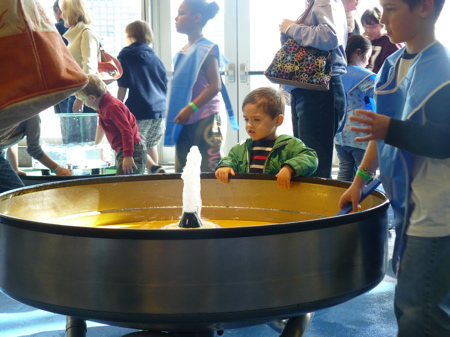
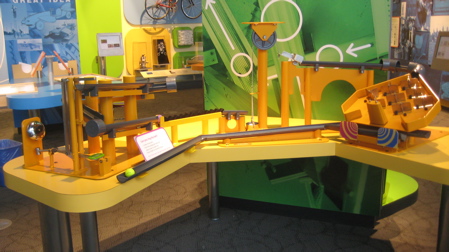
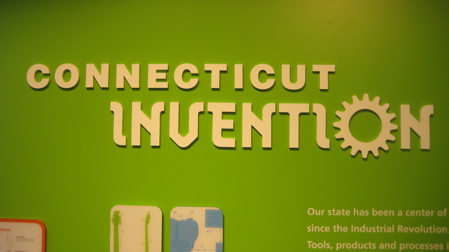
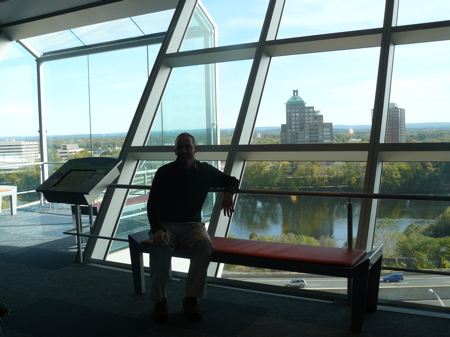
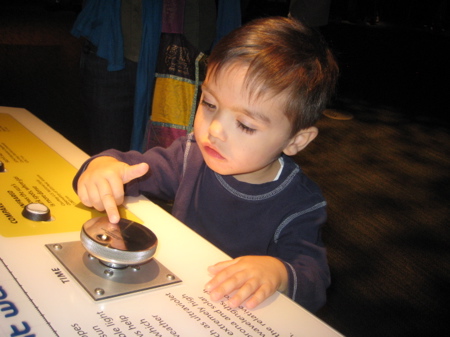
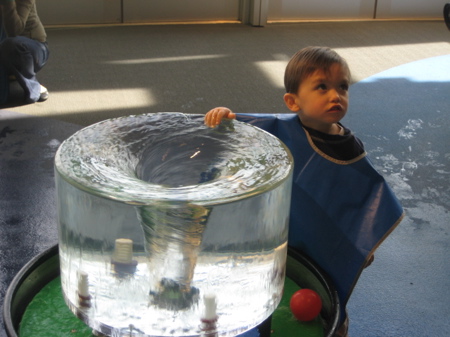
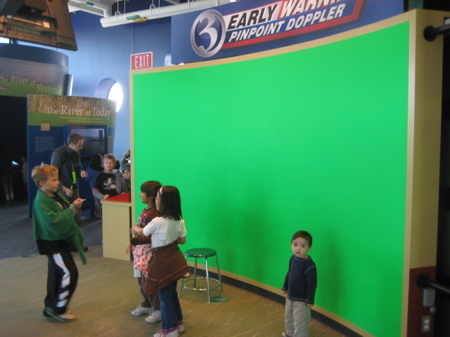
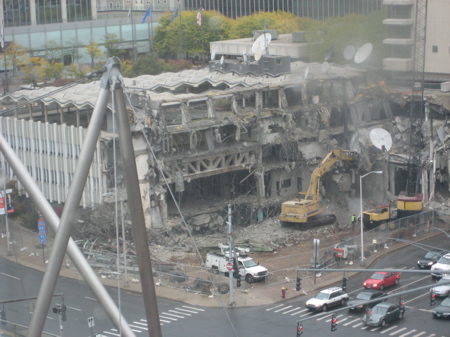
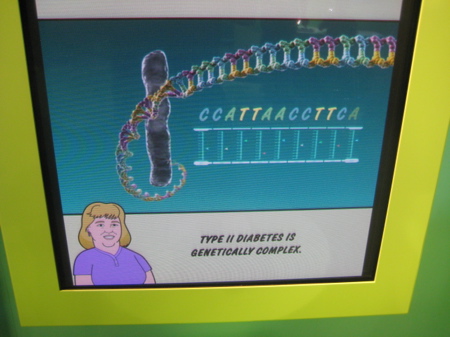
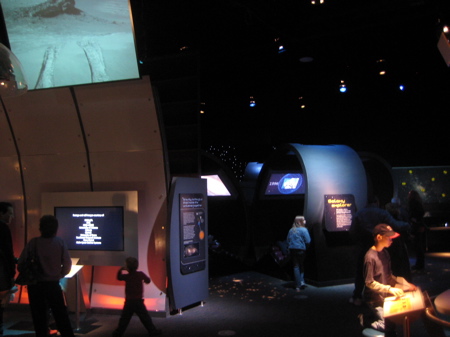
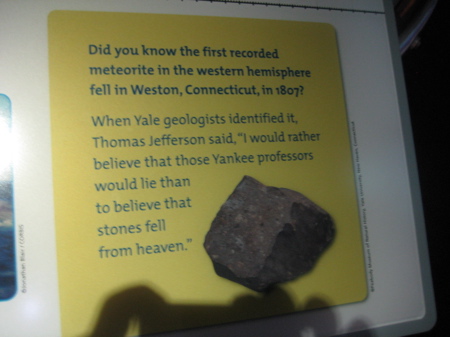
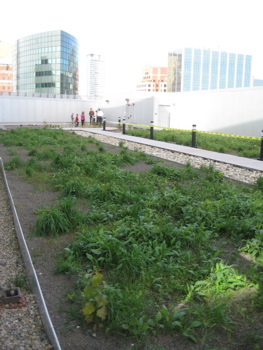
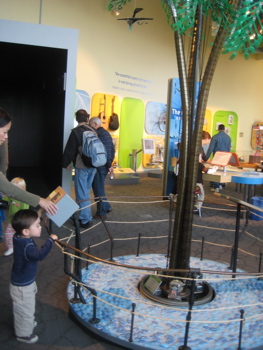
 Kerri says
Kerri says
February 19, 2011 at 12:57 pmI’ve been to the CT Science Center at least six times since it opened and have yet to witness a crack deal.
There was a time when I visited in 2009 where I found a lot of things broken too. When I went last week (by the way, there are some not-so-young and/or quite unattractive people who go to the Liquid Lounge as well) they seemed to be doing better about having exhibits working. I didn’t play with everything in the museum, but I actually don’t recall anything being out of commission.
They really need some kid wranglers up in there though. I brought a friend’s child (smaller than most kids there on field trips) one day, and while I watched like a hawk and intervened a lot on her behalf, I only remember ONE other adult (a parent, not a teacher) actually telling his child to “watch out for the little girl.” Not saying it’s wholly the museum’s responsibility. Parents and teachers should be the ones redirecting their children. But it wouldn’t hurt to have some neutral parties there to assist.
 Steve says
Steve says
February 19, 2011 at 3:49 pmThanks, Kerri – Great to hear they’ve gotten a handle of the “broken stuff.”
 dick hemenway says
dick hemenway says
March 4, 2011 at 3:15 pmSteve
I cannot believe how “right on” you are with this review. I have visited the Science Center twice with my wife’s grandkids (lst time in August 2010)and found it to be a big let down for all the money that was spent on it. The points in your review are spot on with my experience. Lots of broken stuff, little or no supervision to keep kids from hogging displays, long lines at displays, some exhibits seemed to have no point – at least not one that young kids could relate to. High prices for admission, parking and food (cafeteria was filthy). They had a nice Lego display, but the kids (4 and 8) had to create an original design for a simple machine to play with them. For God’s sake, Leonardo D. had a hard time doing that at 50. Acres of space with nothing in it. A giant space for a garden display on the top floor with no plants. A space suit that just begs to have kids pose in it for pictures, but no, off limits. The kids did not absorbe even one science fact or principle from being there twice.
I compare this to the Wonder Works Museum on International Drive in Orlando which is crammed packed with thousands of fun, interesting and easy to understand science-based displays and everything is hands-on, including two space suits that kids and adults can pose in for pictures with their own camera. The admission was reasonable, parking was free, and the place was great. While not specifically billing itself as a “science museum”, the had more science on one floor than the CSC has in the whole place.
Another must-see is, of course, the Boston Musem of Science which runs rings around this one. And If you want to go to the ultimate science museum, take a trip up to Toronto and plan to spend a week in theirs. More than worth the trip!!
Poor design, poor management (let me tell what happened when a fire alarm went off), poor concept and delivery, poor use of resources. Just poor!